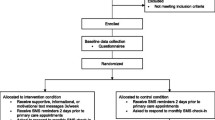ABSTRACT
Urban adolescents face economic, social, and behavioral challenges in adhering to long-term contraceptive use. Use of text messaging reminders has the potential to increase adherence to family planning appointments and to educate patients about safe sexual health practices; however, nonresponsiveness to messages is difficult to interpret and may jeopardize programmatic success. We aimed to understand why adolescent girls enrolled in a randomized, controlled pilot trial (DepoText) designed to increase attendance at family planning visits were periodically nonresponsive to text messages through conducting structured interviews with participants whose text reply rates were less than 100 % during the trial period. Qualitative and quantitative data were collected and classified using descriptive data analysis. Reasons for nonresponsiveness, barriers to continuous cell phone coverage, cell phone plan characteristics, and attitudes toward the DepoText program were the primary endpoints of interest. Most participants (78 %) attributed instances of nonresponsiveness to being away from the phone or due to a personal conflict such as school or work. Service interruption due to bill nonpayment (44 %), phone loss (28 %), and cell phone number change (28 %) were significant barriers to continuous coverage during the trial period, and many respondents indicated that the downturn in the economy made it more difficult to maintain their cell phone plan. Almost a third reported having to choose between cell phone and other payments, but the vast majority (88 %) considered their cell phone a “need” rather than a “want.” Participants universally expressed satisfaction with the text messaging program and reported feeling more connected to the clinic (96 %) through the messages serving as reminders (64 %), encouragement to assume personal responsibility for their health care (12 %), and enhanced personal connection with the clinic staff (4 %). Our study suggests that a text messaging program can be used in an urban clinical setting to communicate with adolescent girls about family planning services. While economic barriers to continuous cell phone coverage do exist, adolescents indicate that the text message reminder system can be a valuable tool for enhancing clinic connectedness and promoting autonomy in care-seeking behavior.

Similar content being viewed by others
References
Santelli JS, Lindberg LD, Finer LB, Singh S. Explaining recent declines in adolescent pregnancy in the United States: the contribution of abstinence and improved contraceptive use. Am J Public Health. 2007; 97(1): 150–6.
Kids Count Data Center: Teen birth rate, Baltimore. http://datacenter.kidscount.org/data/tables/4471-teen-birth-rate#detailed/3/106/false/36,868,867,133,38/any/15346. 2015. Accessed January 22, 2015.
The National Campaign to Prevent Teen and Unplanned Pregnancy: Maryland data. https://thenationalcampaign.org/data/state/maryland. Updated 2015. Accessed January 22, 2015.
A Profile of Health and Health Resources within Chicago’s 77 Community Areas: teen pregnancy. http://chicagohealth77.org/teen-pregnancy/overview/. Northwestern University Feinberg School of Medicine Institute for Healthcare Studies, Center for Healthcare Equality. 2011. Accessed February 1, 2015.
Lindstrom Johnson S, Tandon SD, Trent M, Jones V, Cheng TL. Use of technology with health care providers: perspectives from urban youth. J Pediatr. 2012; 160(6): 997–1002.
Trent M, Tomaszewski K. Family planning appointment attendance among urban youth: results from the DepoText Trial. J Adolesc Health. 2013; 52(2): 88.
Belzer ME, Naar-King S, Olson J, et al. The use of cell phone support for non-adherent HIV-infected youth and young adults: an initial randomized and controlled intervention trial. AIDS Behav. 2014; 18(4): 686–96.
Fjeldsoe BS, Marshall AL, Miller YD. Behavior change interventions delivered by mobile telephone short-message service. Am J Prev Med. 2009; 36(2): 165–73.
van der Kop ML, Karanja S, Thabane L, et al. In-depth analysis of patient-clinician cell phone communication during the WelTel Kenya1 antiretroviral adherence trial. PLoS One. 2012; 7(9): e46033.
AT&T Mobile Safety and Security Study. AT&T web site. http://www.att.com/gen/press-room?pid = 22922&cdvn = news&newsarticleid = 34618&mapcode = Updated June 12, 2012. Accessed April 25 2014.
Lenhart, A. Teens, smartphones, and texting. Pew Research Internet Project. March 19, 2012. http://pewinternet.org/Reports/2012/Teens-and-smartphones.aspx Accessed April 24, 2014.
Grunwald Associates LLC. Living and learning with mobile devices: what parents think about mobile devices for early childhood and K-12 learning. Grunwald Associates., LLC Published 2013.
Funding
The funding for this study is from Thomas Wilson Sanitarium Foundation for the Children of Baltimore City.
Author information
Authors and Affiliations
Corresponding author
Rights and permissions
About this article
Cite this article
Irons, M., Tomaszewski, K., Muñoz Buchanan, C.R. et al. Understanding Adolescent Nonresponsiveness to Text Messages: Lessons from the DepoText Trial. J Urban Health 92, 502–512 (2015). https://doi.org/10.1007/s11524-015-9950-7
Published:
Issue Date:
DOI: https://doi.org/10.1007/s11524-015-9950-7




